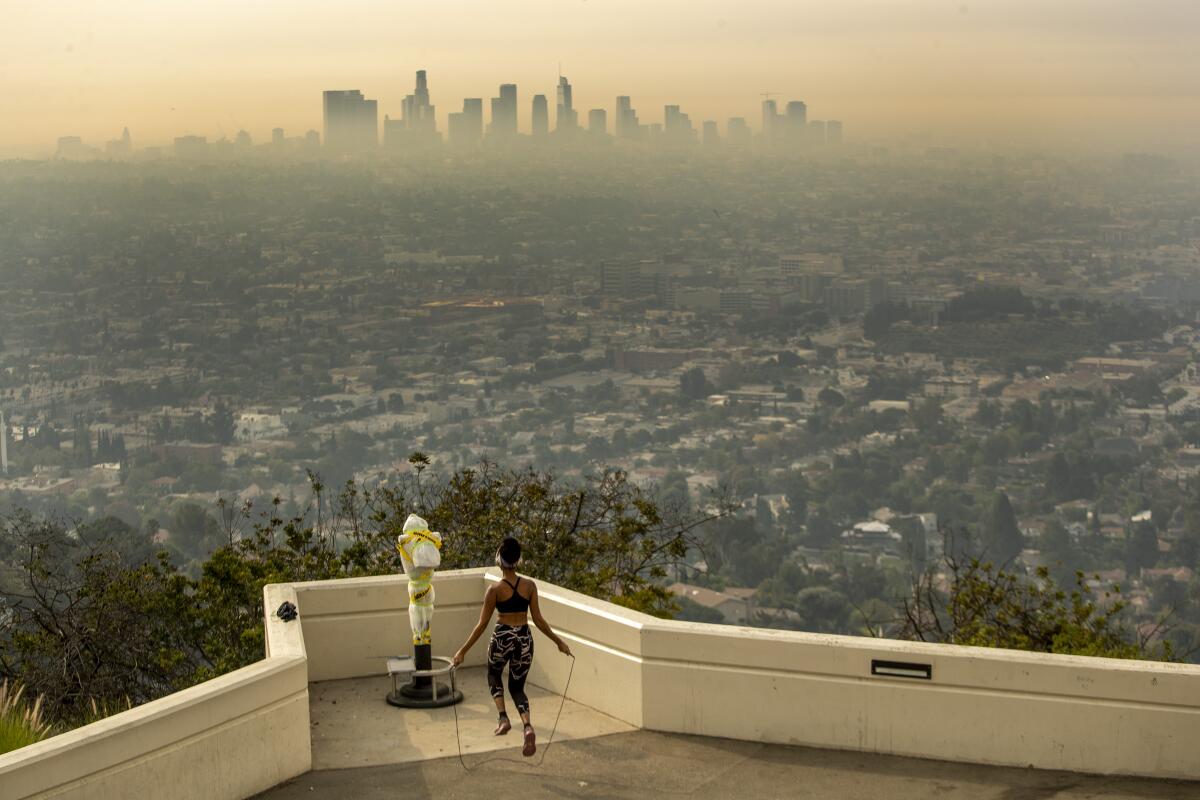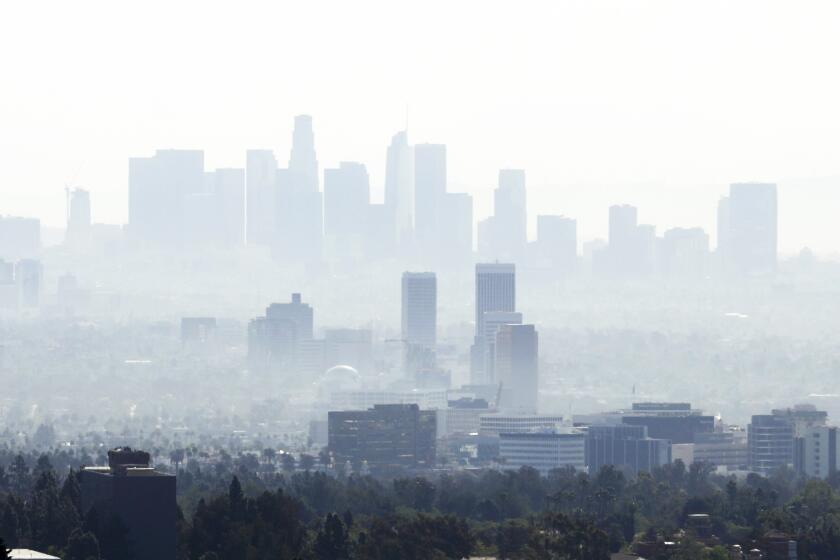Dementia risk grows with increased exposure to air pollution, study finds

Long-term exposure to one of the most prevalent types of air pollution may increase the risk of developing dementia, a debilitating neurological disease associated with memory loss and reduced cognitive function, according to a new study.
Researchers at the University of Michigan have concluded that people living with higher levels of fine particulate matter, or PM2.5, could face a greater risk of being stricken with dementia, according to a study published recently in the Journal of the American Medical Assn.
Scientists monitored the cognitive health of nearly 28,000 people aged 50 or older living across the United States between 1998 and 2016. Fifteen percent of this group developed dementia, and those who lived in areas with more PM2.5 were more likely to succumb to the neurodegenerative illness.
Based on those results, the study estimates fine particulate pollution may be responsible for 188,000 dementia diagnoses each year in the United States. And evidence suggests the health risk may vary with the type of PM2.5 — a catchall term for suspended material about 30 times smaller than the width of a human hair.
New to L.A. and looking for a place to live, I had to quickly educate myself on the region’s largest polluters, its many microclimates and its topography.
Scientists examined exposure to nine different types of particulate ranging from traffic to coal combustion. Exposure to pollution from wildfires and agricultural dust had the strongest ties to the prevalence of dementia, according to Boya Zhang, lead author and research fellow at the University of Michigan.
“The main reason for this distinction may be due to the different physical or chemical characteristics of the PM2.5 from these different sources. All particles are harmful to you, but wildfires and agriculture [dust] may be more harmful to your cognitive health.”
As people live longer and the global population continues to trend older, the findings underscore the importance of limiting exposure to air pollution to cognitive health. But the study also arrives amid a particularly devastating Canadian wildfire season when smoke and soot drifted across North America and engulfed such cities as Chicago and Detroit, highlighting how these intensifying natural disasters can imperil millions of people thousands of miles away.
The research is also concerning for Californians, who have seen their state ravaged by record-setting wildfires and drought that turned thousands of acres of farmland into dust bowls.
The study also serves as a reminder of the sweeping effects air pollution can have on human health. Particulate pollution has already been found to contribute to lung disease, heart attacks, strokes, low birth weight and diabetes.
And, earlier this month, a new study suggested a connection between PM2.5 exposure and the prevalence of antibiotic-resistant bacteria, also known as superbugs. Exposure to PM2.5 can make cell membranes more permeable, making it easier for bacteria to share DNA that would give them immunity to certain antibiotics, according to lead author Hong Chen, of Zhejiang University in China.
The theory that this could accelerate the larger problem of antibiotic resistance has been met with some skepticism, however.
“Just because particulate matter is perhaps increasing the permeability of the cell membrane, that does not necessarily mean that transfer of these antibiotic-resistant genes is going to happen,” said Adam Smith, a USC professor who discovered bacteria in L.A. County wastewater that were resistant to colistin, a last-resort antibiotic.
But the University of Michigan study bolsters a growing body of research linking air pollution to neurological illnesses. In a 2022 study examining the cognitive health of women between 74 and 92 years old, USC researchers found the risk of dementia decreased by 14% in areas with the greatest PM2.5 reductions. In a 2020 study, researchers at UC Davis found evidence that exposure to traffic-related air pollution altered the brain development of rats.
Environmental activists, including actor Daryl Hannah, have seized on Barbie’s popularity to spark a broader conversation about plastic pollution.
Whether cognitive or cardiovascular, the wide-ranging health effects of PM2.5 have been attributed to oxidative stress — the physical toll from the body’s natural response to the entry of foreign objects, which can lead to inflammation.
The severity of oxidative stress depends on the type of PM2.5 a person is exposed to. In the Michigan study, scientists modeled PM2.5 pollution from traffic, agriculture, windblown dust, coal-fired power plants and various industrial emissions, among other sources.
Except for windblown dust, all other sources were correlated with higher dementia prevalence. Surprisingly, wildfires and farm dust had stronger ties to dementia prevalence than traffic pollution and coal combustion.
“This could be partially explained due to the pesticides or herbicides in agriculture, because some ingredients could be neurotoxic,” said Zhang, the Michigan researcher. “For wildfires, we only think about trees or grasslands burning. But it burns everything in their path, including gas stations and houses, emitting some really toxic components.”
This could spell trouble for residents of the San Joaquin Valley, California’s agricultural hub, which experiences the nation’s highest levels of PM2.5 annually from livestock manure and dust. It also emphasizes the need for California residents to protect themselves from wildfires.
“When you inhale any sort of particle, you’re body is going to have some sort of immune response,” said Suzanne Paulson, a UCLA professor of atmospheric and oceanic sciences. “But composition matters because if you’re near the coast, you might be breathing sea salt, which is not that bad for your body to deal with.
“When you have wildfire smoke, you have these big complicated organic molecules that interact with metals very strongly and change their chemistry sometimes ... So that’s why we think that things like wildfire smoke are particularly problematic.”
Much of PM2.5 in Southern California is the result of traffic on the region’s notoriously congested roads. But the composition of this pollution has recently changed, according to Paulson.
Paulson examined PM2.5 across more than 50 locations in Greater Los Angeles. Though vehicle exhaust was once the primary source of particulate pollution in the region, metal particles from brake and tire wear are now a significant and growing source of PM2.5, Paulson said.
It has surpassed tailpipe emissions in recent years, as evidenced by higher copper and iron concentrations. While this trend shows how much cleaner vehicle engines have become, it also underscores an emerging concern.
Pollution from cooking with a gas stove may be on par with breathing secondhand tobacco smoke, according to new research.
As a growing number of heavy electric vehicles hit the road, there could be an increase in metal particles from eroding brakes and tires — and these substances are more toxic than vehicle exhaust.
“The heavier vehicles are going to produce more tire wear for sure,” Paulson said. “A lot of [EVs] have regenerative braking, which probably mitigates some emissions, but we’re not entirely sure if it goes far enough.”
Paulson’s research has already concluded that disadvantaged communities endure the highest concentrations and most toxic types of PM2.5.
The authors of the Michigan study are among a growing chorus of scientists who say new research demonstrates the health benefits of reducing the annual PM2.5 standard. The U.S. Environmental Protection Agency has proposed a rule lowering the federal limit for PM2.5 from 12 micrograms per cubic meter, to 9.
The EPA’s Clean Air Scientific Advisory Committee has recommended the agency lower it to 8.
Nationally, PM2.5 has been significantly reduced over the past two decades. But some emissions, like those from wildfires, are disrupting this progress.
“Global aging and the problem of dementia is becoming more and more serious worldwide,” Zhang said. “We’ve known for a long time that air pollution is a risk factor for respiratory and cardiovascular disease. But we’re only just beginning to understand more about the impact on dementia.”
More to Read
Sign up for Essential California
The most important California stories and recommendations in your inbox every morning.
You may occasionally receive promotional content from the Los Angeles Times.














